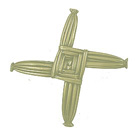You are currently browsing the tag archive for the ‘offerings’ tag.
To those in the Northern hemisphere, I hope you had a wonderful Lá Fhéile Bríde, Imbolc or St Bride’s Day, however you chose to celebrate. I too decided to celebrate on this day, although I am in the Southern hemisphere in a part of the world where the seasons are out of alignment with all of the Gaelic festivals. It is an issue I’ve been struggling with for many years, for celebrating Lá Lúnasa at the moment seems just as out of place, given that Summer is only just beginning. So, I asked Bride to give me some sign if she wished me to honour her feast on the eve of February 1st, and she obliged by unexpectedly getting everyone out of the house so I was free to honour her in privacy.
It was too hot to bake, so I gave offerings of milk and some very nice shortbread, as well as a new beeswax candle. I sained the house, each corner of each room with silvered water, inviting the blessings of Bride on our house, and made a simple bed for the small wooden doll of Bride that resides on my hearth-shrine year round. Next year I would like to weave a proper bed for her and perhaps a cros too, if I can get a hold of some decent material.
I have an open fireplace, but do not burn wood in it so in place of ashes I sieved some flour on the black hearth for divination in the morning. Last thing before bed I went to the front door and invited Bride in, whispering in to the night with my hands on the door jambs.
When I woke in the morning I took the offerings outside, bathed my hands and feet in the tiny amount of dew that had collected on the lawn, and returned to the hearth to look for signs of Bride’s visit. Sadly, there were no marks from her staff or feet, by I did find a single, golden hair curled in a perfect ringlet on top of the flour. Perhaps she did visit after all?
How did you celebrate Bride’s feast?
** When I wrote this I forgot to mention that I celebrated not on February 1st/2nd but a week before on the Gaelic New Moon (first crescent) which is tied, in my tradition, with the beginning of a new month.
 Many who honour Bride choose do so by burning a flame in her name; whether it is the fire on the hearth, the cooking stove or a candle on the shrine or altar. There are many Brigidines who are part of flame keeping orders, and this means burning a flame continually on a day set aside for reverence and prayer.
Many who honour Bride choose do so by burning a flame in her name; whether it is the fire on the hearth, the cooking stove or a candle on the shrine or altar. There are many Brigidines who are part of flame keeping orders, and this means burning a flame continually on a day set aside for reverence and prayer.
We often choose candles for our devotions, as they create less mess and smoke than a wood fire or brazier, and are easy to light and incorporate in to simple daily practices. However I think it is important to consider the type of candle you’re using, and whether it is really the best one for honouring Bride and for your own health.
Most of the candles we buy in shops are made from paraffin wax, a toxic bi-product of the petroleum industry that is then bleached with further chemicals and gives off harmful fumes when burnt.
A recent alternative to this are the popular Soy or Palm oil candles, which are cheap and burn for longer than paraffin. Unfortunately, they are not so good for the environment, as land all over south east Asia is currently being cleared to grow the plants that produce these oils.
From a Re-constructionist perspective, neither Paraffin nor Soy candles are historically accurate. The oil most commonly burned in European history would have been tallow, or animal fat, with Beeswax reserved for those who could afford it. Now, Beeswax candles, while still the most expensive on the market, are much more affordable to most of us and I believe they are the best choice in any spiritual practise, and as an offering to Bride are ideal.
Why?
- Beeswax candles actually help purify the air in the rooms they are burnt through ionisation
- Beeswax burns with a slight honey scent, surely a better offering than burnt petrol?
- Beeswax burns longer than any other wax and is ideal for flamekeeping and vigils
- Beeswax burns with a more golden flame than other waxes
- Beeswax candles were traditionally brought to church to be blessed on Candlemas day
- The higher cost of Beeswax makes it a more valuable offering than cheap paraffin
- By buying locally made Beeswax you are incorporating something of the land in to your offering
- You can safely make Beeswax candles yourself and show your devotion through crafting them especially for this purpose
- While Bride herself may or may not be associated with Bees, she is associated with the flowers they make the wax from, the process of purification, the golden colour and traditions of Candlemas day, which falls the day after her own feast
I invite you to try burning a pure beeswax candle for your next vigil, or to honour Bride on a festival day. You will be surprised at the difference and may find it hard to go back!

